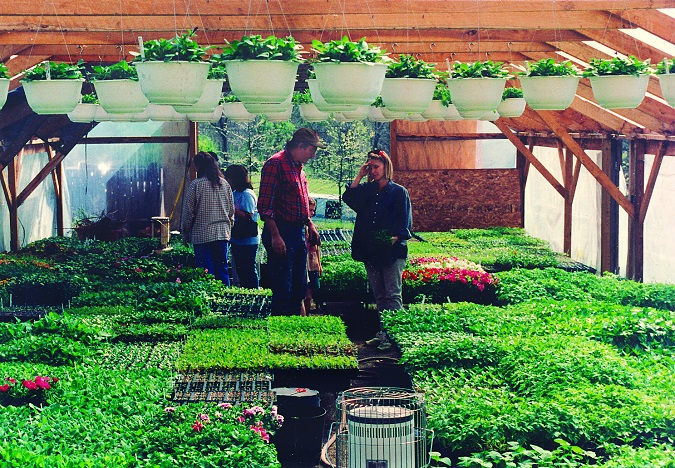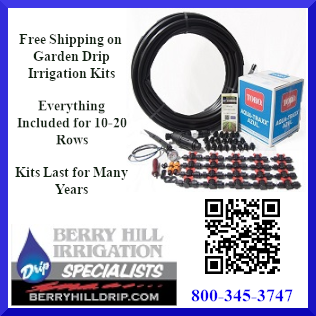
In an article recently published on MyGardenAndGreenhouse.com choosing the right size and location for your greenhouse was discussed. If you missed it, click here to read the article. Determining the correct size and location is necessary before buying a greenhouse kit or building your own.
Manufactured greenhouse kits are available in many sizes. They are designed to make heating, ventilation, and watering efficient and easy for the grower. If convenience and ease is a priority for you, consider a manufactured greenhouse.
You will find endless styles and sizes on the Internet and in catalogs from greenhouse suppliers. These companies will gladly provide you with information on the various types of construction and coverings available.
Except for smaller greenhouses made from permanent panels, commercial ones are commonly covered with one or two layers of 6-mil greenhouse film. It is specially manufactured to resist ultraviolet deterioration, extending the life of the film. Most are guaranteed to last four years and usually last longer when protected from high winds. Since companies also manufacture construction and mulch-grade plastics, make sure you are getting greenhouse film that is resistant to the effects of ultraviolet rays.
Blowers are available to fill the layers of film with air and provide better insulation against the cold. Greenhouse manufacturers can provide heat-saving information for air-filled layers of plastic.
Building your own greenhouse offers you even greater flexibility and usually costs much less than manufactured kits. Although kits are available in many sizes, you can design and build a greenhouse in any size or shape, using a wider range of materials.
I live in a heavily forested area of the country and until recently wood was relatively inexpensive. Given your area of the country and the price of various building materials, compare relative costs for owner-built greenhouses and pre-made kits.
All my greenhouses were owner-built. Each was designed to fit my space and particular needs. All frames were built using wood. The last one, 30′ x 84′, is anchored in concrete. Because it is in a high wind area, I use a 6-mil woven greenhouse film. It is about twice the cost of the more common type, but it will withstand stronger winds and lasts longer. Each greenhouse was built for a fraction of the cost of a similar-size kit.
Regardless of the type of greenhouse you choose, the plastic film eventually will need to be replaced. I line up a half-dozen strong friends or customers whom I can call on short notice when the wind is not blowing, and they help me put on the new cover.
All my temporary structures are made from galvanized pipe and are easy to assemble and remove as my needs for them change. They are covered with regular 6-mil greenhouse film.
Anyone who has basic carpentry skills or experience with framing small barns and sheds can design and build a greenhouse. The larger the structure, the more skill required. Generally, construction principles are the same except for the spacing of rafters or trusses. When plastic and snow are the only weight the roof will carry, rafters in my area can be spaced 6 feet on center. Snows, deep and heavy enough to destroy the greenhouse, are so rare in southeast Ohio it is not worth the extra cost to place rafters closer together. When snow is expected to accumulate to dangerous levels, keeping the greenhouse above freezing will melt the snow on contact, preventing buildup. In my area, wet, heavy snows usually occur while the greenhouse is in use and already heated. If not, I use the flat side (smooth) of a long-handled, lightweight aluminum rake to remove most of the snow from the roof.
An excellent book on building small- to medium-size greenhouses is Greenhouses for Homeowners and Gardeners by John W. Bartok, Jr. If you prefer to build the frame from galvanized steel or aluminum, or plan to use glass or rigid panels, this book is the best I have read. It is filled with practical information on planning, building, obtaining permits, heating, cooling, and lighting. It provides drawings of construction details and several greenhouse styles.
How do you plan to heat and cool the greenhouse? Manufactured systems are designed to maintain a constant temperature in the entire greenhouse and require a large supply of fuel or electricity. They are usually thermostatically controlled and very convenient, except when the electricity goes off and the fans stop working.
A greenhouse containing several varieties of plants in different stages of growth will benefit from a more flexible heating system. Whether you purchase a kit without heating equipment or build your own greenhouse, there are less expensive heating options.
A piece of plastic can be dropped from any rafter to heat only the space in use. On warm days it can be raised to allow air circulation throughout the greenhouse. I use kerosene heaters, which I move around and place in sections where plants require more warmth at night. Because of their simple design I can repair them and replace the wicks myself. They continue to operate when the electricity goes off, which is a bonus. Cold-tolerant plants need less heat and often require only the protection of insulating blankets.
Good ventilation is essential when you are growing plants susceptible to molds and fungi. On cool days, fans can be placed in areas where they are needed. On hot days, natural ventilation can be provided with large doors and vents framed into the top of the roof. As the heat escapes through the vents, cooler air will be pulled into the greenhouse through open doors.
Before building, decide where the water will enter the greenhouse and how it will be distributed. Some automatic systems are appropriate for smaller operations and can be adapted to almost any greenhouse. Before including an automatic watering system in your greenhouse plan, check its requirements. Water pressure and volume, needed for some automatic watering systems, is greater than many properties taps and wells can provide.
Automatic watering systems usually operate on the principle that all plants require the same amount of water. However, in my greenhouse there are several types of plants in different stages of growth, many requiring different amounts of water. How much water plants need will vary according to plant size, greenhouse temperature, and how sunny, cloudy, or rainy the day may be. With a long commercial-grade hose and different size watering wands and nozzles, I can provide each section of plants with the right amount of water.
Gini Coover is the author of The Natural Greenhouse, Growing Plants and Food for Profit. She has grown greenhouse plants and vegetables for over 30 years, selling retail and wholesale from her greenhouse.
Related Articles & Free Email Newsletter Sign Up
Common Sense Insect and Disease Control in a Natural Greenhouse
Educating Your Customers Leads to Higher Sales
How to Market Naturally Raised Plants and Vegetables




Comment here